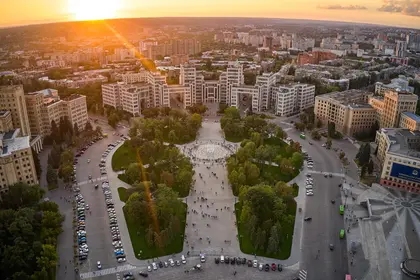Kharkiv, UKRAINE — Kharkiv is a notorious city in northeastern Ukraine.
It’s been governed by pro-Kremlin authorities for most of the country’s independent history. It also had a large opposition movement to the EuroMaidan Revolution that ousted ex-President Viktor Yanukovych.
JOIN US ON TELEGRAM
Follow our coverage of the war on the @Kyivpost_official.
So when Russia invaded Donetsk and Luhansk Oblasts next door, many feared Kharkiv Oblast, a majority Russophone region on the Russian border, would follow.
But it didn’t. In fact, Kharkiv has a history of fighting for Ukraine, which can be explored with a visit to this city of 1.4 million people, 480 kilometers northeast of Kyiv. And history is just one of its many attractions.
Weapons and words
Kharkiv was founded by the freedom-loving Cossacks in 1654. Kharkiv cossacks fought against Russia and the Polish–Lithuanian Commonwealth, until Cossack Ukraine was split between the two in 1686.
Modern Kharkiv pays tribute to the Cossack era with monuments to Kharko, the mythical founder of the city, and Ivan Sirko, the legendary leader of Zaporizhian Host.
Kharkiv gave Ukraine one of the country’s first universities, founded in the 19th century. Though established by the Russian Empire to “Russify” the population, the university did just the opposite.
The institution attracted and educated a cohort of intelligentsia that would explore Ukraine’s past in historical pieces, portray its distinct culture in literary works and develop ideas for its future independence. It gave birth to press that cultivated Ukrainian culture despite tsarist suppression.
The university is still open today, now named after its founder Vasily Karazin, and has a student body of 16,000. Though it hasn’t retained its original look, its new main building, a giant 14-floor constructivist structure located in the city center, is well worth a visit.
Under Soviet rule, Kharkiv was the Ukrainian capital for 15 years, in 1919–1934, serving as the country’s main cultural, scientific and intellectual center.
Later on, despite Joseph Stalin’s crackdown on dissent, Kharkiv’s intelligentsia continued to stand for Ukraine’s freedom.
Many writers and artists would gather in an apartment building called Slovo (“Word”), where they advocated a move away from Russia, towards Europe. “Away from Moscow!” was the motto of Mykola Khvylovy, the informal leader of Slovo.
The KGB killed most of the community members in the 1930s. They are considered to be the first generation of murdered Ukrainian artists known as the Executed Renaissance.
Slovo still stands today on the intersection of the green and quiet Literaturna and Kultury streets. Locals use it as a residential building but a plaque commemorates the 123 courageous artists who have been killed but never forgotten.
Although Kharkiv’s pro-Kremlin authorities had a lot support in 2013–2014, there was also a big uprising in support of the EuroMaidan Revolution.
It was one of the first cities to protest in solidarity with Kyiv, eventually growing to be one of the biggest demonstrations in northeastern Ukraine. The activists met daily at the central Svobody (Freedom) Square, withstanding attacks from law enforcers and hired thugs.
A yellow-blue protest camp tent set up in 2014 during the revolution has remained there since. Despite the authorities’ attempts to remove it, the tent still stands there as a reminder of Kharkiv’s movement.
Two sides
Kharkiv’s two main streets that date back to the 17th century reflect the city’s two extremes of renovation and neglect.
Sumska Street, a downtown unto itself, is the modern version of Kharkiv, with its restored historic facades, clean parks, refreshing fountains, bright lights and comfortable restaurants.
But just like many other Ukrainian cities, Kharkiv has a flip side.
The back streets are filled with shabby old buildings, their decay contrasted against the grandeur.
The other key Kharkiv street, Poltavskyi Shliakh, also conveys abandonment. Once an important highway leading to the nearby Poltava city, the street has been neglected since the city center relocated to Sumska Street.
Poltavskyi Shliakh is still full of architectural heritage from the Russian Empire and the Soviet Union. The street has echoes of its former grandeur — a 19th-century firehouse with a working observation tower and one of the oldest cinemas in Eastern Europe called Bommer. Though now on the brink of bankruptcy, the cinema has been screening films since 1908.
Cultural and green
Kharkiv is considered one of Ukraine’s key cultural centers for its vibrant theater, literary and music scenes. Having nearly 50 universities with more than 160,000 students, it is also often referred to as “a student city.”
But Kharkiv is also known as the “green” city. Leafy parks and trees along the roads are as essential to the Kharkiv cityscape as historic buildings.
Travelers might have to get on the Ferris wheel in Maxim Gorky Park to see over the tops of the trees and to get an aerial view of the city.
There’s plenty of other attractions in this amusement park also known as Kharkiv’s “Disneyland.” Visitors can observe youngsters skating, babushkas dancing to retro music, children running around with cotton candy and their parents enjoying the moment.
Another green pearl of the city is Shevchenko Park, a get-together place for street musicians and activists. The heart of the park is a monument to legendary poet Taras Shevchenko depicting characters from his poems. One of them is a Cossack with a sparkling polished toe. Kharkivans believe that if one holds his toe and makes a wish, it will come true.
Though the monument was installed in 1935 Soviet Kharkiv, there is no truer Ukrainian emblem than Shevchenko. And it’s no wonder it has been one of the main symbols in a truly Ukrainian city.
You can also highlight the text and press Ctrl + Enter





